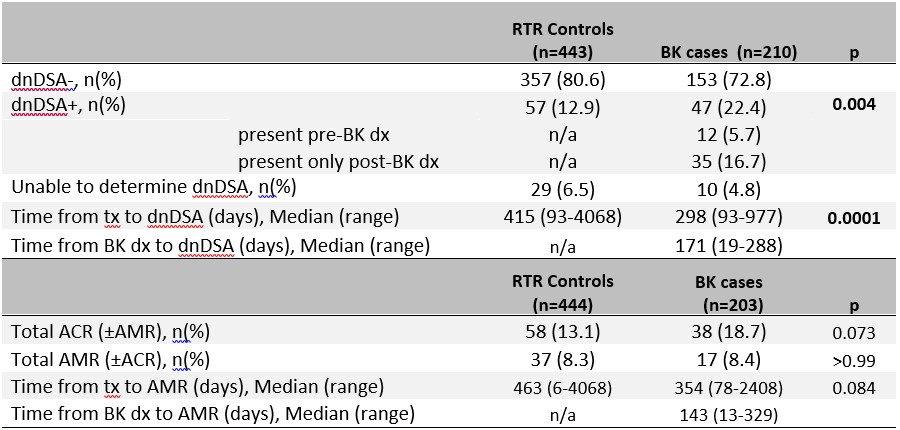Development of De Novo Antibody in Renal Transplant Recipients with BK Viremia Managed with Immunosuppression Reduction
1SUNY Upstate Medical University, Syracuse, NY, 2Northwestern University, Chicago, IL, 3University of Santiago, Santiago, Chile
Meeting: 2021 American Transplant Congress
Abstract number: 448
Keywords: Antibodies, Polyma virus, Rejection
Topic: Clinical Science » Infectious Disease » Kidney: Polyoma
Session Information
Session Time: 7:30pm-8:30pm
 Presentation Time: 7:40pm-7:50pm
Presentation Time: 7:40pm-7:50pm
Location: Virtual
*Purpose: To evaluate development of de novo donor specific antibodies (dnDSA) in Renal Transplant Recipients (RTR) with immunosuppression (IS) modulation due to BK viremia (BKV) and the associated risk of antibody mediated rejection (AMR).
*Methods: We retrospectively collected data from the NM Enterprise Data Warehouse, primary review of biopsies and HLA antibody testing on all RTR 2007-2017 at our center (n=1911). BK case group included pts who developed BKV >10,000 c/ml or biopsy proven BKV and nephropathy (BKVN), with DSA and biopsy reports through 1 yr post-BK diagnosis. Per protocol, MMF was reduced initially at the direction of the transplant nephrologist. Two controls without BKVN or BKV were matched for each case by gender, donor type and transplant within 1 yr.
*Results: 248/1911 RTR (12.9%) had BKV or BKVN. Despite the lower HLA antigen mismatch load (mean=3.5 vs 4.3, p<0.001), the rate of dnDSA was significantly higher in the BK group compared with controls (22.4% vs 12.9%, p=0.004) and the median time from transplant to dnDSA was significantly shorter (298d vs 415d, p<0.001). Interestingly, the incidence of dnDSA was much higher following the diagnosis of BK (16.7% vs 5.7% dnDSA prior to BK diagnosis). There were no significant differences in dnDSA characteristics between BK cases and controls with regards to DSA class, Peak Abs titer, DSA locus etc. AMR was diagnosed in 17/203 (8.4%) biopsied BK and 37/444 (8.3%) biopsied control patients, and the median time from transplant to AMR was lower in the BK group compared with the controls, although the difference did not reach statistical significance (354d vs 463d, p=0.08).
*Conclusions: Overall dnDSA rates were higher in BK cases than in control group, with the majority of dnDSA developing following IS reduction for BKVN, and earlier post-transplant. AMR rates were similar between cases and controls, although AMR was more likely to occur earlier post-transplant in the BK cases suggesting a link between IS reduction and the generation of dnDSA.
To cite this abstract in AMA style:
Dvorai RHod, Lee R, Muluhngwi P, Raijmakers M, Shetty A, Tambur A, Ison M. Development of De Novo Antibody in Renal Transplant Recipients with BK Viremia Managed with Immunosuppression Reduction [abstract]. Am J Transplant. 2021; 21 (suppl 3). https://atcmeetingabstracts.com/abstract/development-of-de-novo-antibody-in-renal-transplant-recipients-with-bk-viremia-managed-with-immunosuppression-reduction-3/. Accessed December 21, 2025.« Back to 2021 American Transplant Congress

